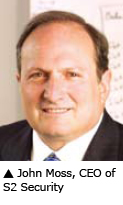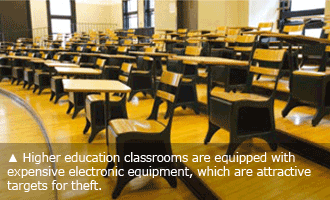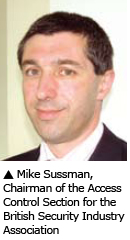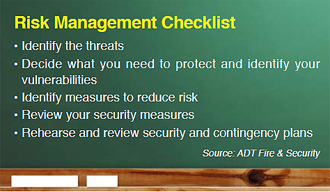Colleges and universities offer advanced learning in an open environment. This openness welcomes students and faculty, but can also introduce risks.
Colleges and universities offer advanced learning in an open environment. This openness welcomes students and faculty, but can also introduce risks.
The Virginia Tech shootings in 2007 were a chilling example of senseless violence. While no amount of equipment could have prevented the killings, a number of warning flags went up to no avail. Had a better system for reporting violent behavior been in place, school authorities could have responded faster and limited the body count.
Alerting an entire campus about a shooting is no easy task, making notification an essential part of college security. From telephones, mobile text messages to e-mail, newer forms of communication can now tip off students and faculty en masse. This notification method can be deployed for other emergencies, such as earthquakes or gas leaks.
Traditional access control is difficult to apply at campuses, which are made up of multiple buildings and entrances. It is largely deployed for individual buildings, with smart cards for student IDs granting access to designated areas, enabling payment and checking out books. A school access control system is less about keeping people out and more for convenience.
Video records are kept for evidentiary purposes at schools. As foot traffic is usually heavy at a university, cameras help officers have more eyes in more places. Surveillance deployments vary greatly by country and privacy legislation, but are more for safety than catching crooks.
Higher education institutions enjoy speedy Internet networks, making them more IP-savvy. The migration to IP enables integration among security and nonsecurity systems, so schools can respond faster to threats without investing in new infrastructure.
While equipment helps, any school must thoroughly consider why it wants to install security. Campus security or building administrators will usually identify a need, request funding and then seek outside help. A group of experts, including consultants and installers, decide what equipment best serves the institution's needs. They also will perform a risk assessment and draft a response plan, so the security system, both equipment and personnel, works effectively.
At the end of the day, there is no magic bullet to eliminate school violence. It is up to universities and colleges to check for warning signs, plan for the worst and take the appropriate measures. Student safety is paramount for learning and education security.
 Higher-education institutions offer learning and growth opportunities to students. With a college degree being a prerequisite for most careers, more people continue their schooling past K-12. These students are more independent, but are also more vulnerable in less controlled environments.
Higher-education institutions offer learning and growth opportunities to students. With a college degree being a prerequisite for most careers, more people continue their schooling past K-12. These students are more independent, but are also more vulnerable in less controlled environments.
Solutions for higher education are more complex, compared to primary or secondary schools. “This is principally due to increased campus size and an altering student body which has the potential to attract threats more frequently,” said Muriel Runnalls, Marketing Manager for the Public Sector at ADT Fire & Security. “Therefore, suppliers need to be able to develop and implement convoluted integrated fire and security systems to meet these growing objectives.”
 In APAC, the video surveillance market for education — including K-12 schools and higher education — was estimated to be US$50 million to $60 million in 2008 and is expected to reach $350 million to $400 million by 2015, said Parul Oswal, Industry Analyst, Frost & Sullivan. During this period, the market is expected to experience a CAGR of 30 percent.
In APAC, the video surveillance market for education — including K-12 schools and higher education — was estimated to be US$50 million to $60 million in 2008 and is expected to reach $350 million to $400 million by 2015, said Parul Oswal, Industry Analyst, Frost & Sullivan. During this period, the market is expected to experience a CAGR of 30 percent.
Video uptake is expected to increase in the U.S. over the next five years, according to the Frost & Sullivan report “2010 US Physical Security Solutions within the Education Areas.” It surveyed 116 security decision-makers in the U.S., with 56 percent at higher education institutions and 44 percent at K-12 schools.
Classroom Conditions
A college or university has a more mature and mobile demographic. “Because students are older, security issues tend to be more complex than in K-12 facilities,” said Gadi Piran, President of OnSSI. “For example, college or university security teams are much more likely to face incidences of more serious crimes.”
Unlike an elementary school, a college is not a single building with controlled access. “In effect, a typical campus setting is like a mini city, with many thousands of people living there nine to 10 months of the year, and in some instances, all year-round,” Runnalls said.
 “It is important for colleges and universities to be able to balance an appropriate level of freedom of movement with a need for access control,” said John Moss, CEO of S2 Security. Universities typically control access to certain facilities such as dormitories or laboratories, but students may prop doors open. Some schools deploy access control systems which detect for doors left open, so unauthorized people do not get in.
“It is important for colleges and universities to be able to balance an appropriate level of freedom of movement with a need for access control,” said John Moss, CEO of S2 Security. Universities typically control access to certain facilities such as dormitories or laboratories, but students may prop doors open. Some schools deploy access control systems which detect for doors left open, so unauthorized people do not get in.
Schools are on alert about off-campus strangers as well as their students. “The challenge that most schools face is not some threat from outside the school but from within its own student body,” said Peter Brissette, owner of www.cctv-security- camera-systems.com. “The real challenge is investigating possible threats before they even happen. The next step then is to be prepared in how you deal with a situation once it happens. Being able to respond quickly and alert the campus immediately is key.”
In light of the Virginia Tech tragedy, US schools are seeing the importance of quickly pulling someone's access or locking down a facility at a moment's notice, Moss said.
“Universities are mainly concerned for the safety of their students, faculty and staff in all events,” said Grant Copple, US Sales Lead for UTC Fire & Security. “There is an emphasized concern today about effectively communicating with the entire campus in the event something catastrophic happens.”
What's at Stake?
 Campus location affects each institution's threat level. “Suburban universities are typically looking to protect against vandals or unacceptable behavior from students, such as public intoxication and fighting,” said Paul Bodell, CMO of IQinVision. “Urban universities have those same challenges, and must also guard against criminals from adjacent areas who will prey on students and faculty.”
Campus location affects each institution's threat level. “Suburban universities are typically looking to protect against vandals or unacceptable behavior from students, such as public intoxication and fighting,” said Paul Bodell, CMO of IQinVision. “Urban universities have those same challenges, and must also guard against criminals from adjacent areas who will prey on students and faculty.”
A downtown location could offer convenient access to retail stores, pubs and train stations, said Wai-King Wong, Country Manager for Australia and New Zealand, Axis Communications. However, this convenience could become a problem at night, with people walking into the campus. “Vandalism is very high; that's a given,” he said.
A city setting makes it easier for strangers to come and go. “If the site is situated in a town or city, entering the site tends to be an easier task; and if the premises have a large area of land, such as athletic fields, gaining access is not a problem,” said Mike Sussman, Chairman of the Access Control Section for the British Security Industry Association. “ F u r t h e r m o r e , schools, colleges and universities tend to have a large transient population, making a trespasser or criminal's intentions a lot easier to carry out.”
 College campuses house pricey equipment, making pilferage an expensive headache. “ The fact that modern classrooms are equipped with projectors, computers, printers and other technological tools make school campuses prime t a rgets f o r equipment theft,” said Ian Scott, VP of the Physical Security Group for the U.S., Professional Products, Victor Company of Japan (JVC). “In addition, the personal property of students and staff is also vulnerable. These days, students regularly bring a variety of high-value portable electronics on campus, including laptops, MP3 players and advanced mobile phones. Spend a little time on campus and you'll see students leave those items unattended in libraries and other common areas with regularity, making it easy for thieves to strike.
College campuses house pricey equipment, making pilferage an expensive headache. “ The fact that modern classrooms are equipped with projectors, computers, printers and other technological tools make school campuses prime t a rgets f o r equipment theft,” said Ian Scott, VP of the Physical Security Group for the U.S., Professional Products, Victor Company of Japan (JVC). “In addition, the personal property of students and staff is also vulnerable. These days, students regularly bring a variety of high-value portable electronics on campus, including laptops, MP3 players and advanced mobile phones. Spend a little time on campus and you'll see students leave those items unattended in libraries and other common areas with regularity, making it easy for thieves to strike.
Universities may also need to consider mundane threats like kidnapping as well as larger-scale threats of terrorism, including biological and chemical attacks, said Terence Lee, Director of Product Management for APAC, Ingersoll Rand Security Technologies.
Studying Integrators
 While schools are relatively safe places, they have unique concerns for security. Solutions should be unobtrusive, yet highly effective for a large population concentrated in one place. This requires a qualified integrator to get the job done. “We have a very large database of integrators that we have established through the years,” said David Benhammou, President of CDVI Group. “We meet with each integrator and evaluate their capacity to handle various integrations.”
While schools are relatively safe places, they have unique concerns for security. Solutions should be unobtrusive, yet highly effective for a large population concentrated in one place. This requires a qualified integrator to get the job done. “We have a very large database of integrators that we have established through the years,” said David Benhammou, President of CDVI Group. “We meet with each integrator and evaluate their capacity to handle various integrations.”
Sometimes, the institution chooses the integrator. “The end users already have select integrators in mind,” Wong said. “We ask which integrator they have in mind and then go from there.”
Mos t manufacturer s offer training to system integrators who specialize in education. “We select those system integrators based on reputation, previous experience and technical expertise,” Moss said.
An integrator needs to understand each campus' needs. “From analog and network cameras to monitors and NVRs, we want to make sure all installations  are as effective as possible,” Scott said. Some work with system integrators, consultants and distribution channels to make sure the right products are specified for the location and application.
are as effective as possible,” Scott said. Some work with system integrators, consultants and distribution channels to make sure the right products are specified for the location and application.
Brivo Systems also works with consultants, architects and engineers. “System integrators often find Brivo, rather than the other way around,” said Steve Van Till, President and CEO. “We have focused our communication and education efforts on the fit between hosted services and wide geographic dispersion of facilities.”
For some projects, the integrator needs to install multiple systems. “Each partner brings their own unique qualities to the table, so that when we discuss issues such as security and presence management, we can not only promote the reliability and value of our system, but work with the school to provide a comprehensive solution,” said Simon Bright, Business Development for UK Education, Nedap. This could include services such as surveillance or cashless payment.
The integrator is required to work with a team of other players, including manufacturers, distributors and possibly the institution's IT department. “The role of the system integrator is to ensure smooth operation of the final system,” Piran said. “The fact that most colleges and universities have a robust networking infrastructure, sometimes including fiber optics, can make integration even smoother.”
An integrated system requires upkeep for sustainability, so most institutions have maintenance agreements with their integrators. “Partners must have the capacity  to not only install the system but also have the capacity to provide a good optimum maintenance service to the school,” Lee said. “Working with schools themselves is important to identify each individual school's unique requirements, as no schools are alike.”
to not only install the system but also have the capacity to provide a good optimum maintenance service to the school,” Lee said. “Working with schools themselves is important to identify each individual school's unique requirements, as no schools are alike.”
While the security team operates the equipment, the integrator needs to be on-hand to address any issues. The installer will place the cameras, but access to the cameras and VMS is done by the institution's IT department, such as assigning IP addresses. “For physical issues, they call the integrators,” Wong said. “For network issues, they call the IT team.”
Specifying Security
With all the talk about integration, it is still unusual for physical security to be specified with the IT system. “Security is typically bid separately from other IT or communication systems,” Brissette said. “Many schools will actually build completely separate networks for their security systems so as not to create competition for bandwidth with their standard network.”
Most schools bid for security after buildings are done. “Projects are typically retrofits, since the school's already there,” said JP Yang, Manager of the Professional Project Support Team, VIVOTEK. “New greenfield schools get turnkey solutions, which are very rare.”
 However, some schools put security on their networks. “In the past, many universities had separate security and IT functions, but today we see them integrated,” Bodell said. “Security is responsible for dealing with the people, IT is responsible for dealing with the technology.”
However, some schools put security on their networks. “In the past, many universities had separate security and IT functions, but today we see them integrated,” Bodell said. “Security is responsible for dealing with the people, IT is responsible for dealing with the technology.”
The common language of networking has enabled some schools to bypass outside technicians altogether. “One other interesting trend we've observed is the number of universities who self-install network cameras and access control systems,” Bodell said. “They generally have a very competent technical staff and are quite capable of doing a lot of the installation and later maintenance work themselves.”
Decision Makers
As campuses gather large student populations, keeping them safe is a top priority. Colleges rely on administrators to let security expenditures pass. “Building administrators have the highest influence in the selection of security systems,” found the Frost & Sullivan US survey. “Decisions are being made based primarily on the functionality of security systems. While ROI is measured in a variety of ways, threat and manpower reductions are core measures within most education facilities.”
Once an expense makes the grade, institutions seek additional help. “Many large school projects involve professional consultants who identify products that will work reliably in the specific environment,” Bodell said.
In the U.K., equipment procurement requires an OK from the top. “Although security managers are involved in the buying decision, it is typically the principal or president who makes the final decision on whether or not security equipment can be purchased,” Runnalls said. “Typically, the head of security will pitch a request through his departmental decision maker for some of the budget to install a security system.”
 “As adoption of IP-based security continues, the need to consult with the IT management of a site has increased,” Runnalls said. “This has lead to the procurement of security migrating from the security/ loss prevention area to the IT management area and as a result is becoming an integral part of the IT infrastructure.”
“As adoption of IP-based security continues, the need to consult with the IT management of a site has increased,” Runnalls said. “This has lead to the procurement of security migrating from the security/ loss prevention area to the IT management area and as a result is becoming an integral part of the IT infrastructure.”
The bid process can involve input from multiple stakeholders, including the IT department, administrators and even faculty and students. “Trying to meet all those entity needs can sometimes make a specification unclear and lack some desired detail for an appropriate response,” Copple said. “We work very closely with our A&E partners and channel partners to ensure we are providing the desired solution for the requested need.”
Once a bid is approved, specifications must be drawn up. It is essential that a designated body takes responsibility for maintenance and training, as well as objectively selecting the best solutions.